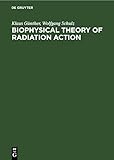Biophysical Theory of Radiation Action : A Treatise on Relative Biological Effectiveness / Wolfgang Schulz, Klaus Günther.
Material type: TextPublisher: Berlin ; Boston : De Gruyter, [2022]Copyright date: 1983Edition: Reprint 2022Description: 1 online resource (368 p.) : with 80 Figures and 32 TablesContent type:
TextPublisher: Berlin ; Boston : De Gruyter, [2022]Copyright date: 1983Edition: Reprint 2022Description: 1 online resource (368 p.) : with 80 Figures and 32 TablesContent type: - 9783112618936
- 9783112618943
- 574.19/15 19/eng/20230216
- online - DeGruyter
- Issued also in print.
| Item type | Current library | Call number | URL | Status | Notes | Barcode | |
|---|---|---|---|---|---|---|---|
 eBook
eBook
|
Biblioteca "Angelicum" Pont. Univ. S.Tommaso d'Aquino Nuvola online | online - DeGruyter (Browse shelf(Opens below)) | Online access | Not for loan (Accesso limitato) | Accesso per gli utenti autorizzati / Access for authorized users | (dgr)9783112618943 |
Browsing Biblioteca "Angelicum" Pont. Univ. S.Tommaso d'Aquino shelves, Shelving location: Nuvola online Close shelf browser (Hides shelf browser)

|

|

|

|

|

|

|
||
| online - DeGruyter Information I. Studie zur Vielfalt und Einheit der Information : Theorie und Anwendung vor allem in der Technik / | online - DeGruyter Formale Beschreibung von Programmiersprachen : Eine Einführung in die Semantik / | online - DeGruyter Lokale Netze / | online - DeGruyter Biophysical Theory of Radiation Action : A Treatise on Relative Biological Effectiveness / | online - DeGruyter Analysis und mathematische Physik / | online - DeGruyter Hegel-Bilder : Kritik der Hegel-Deutungen / | online - DeGruyter RGW – DDR : 25 Jahre Zusammenarheit / |
Frontmatter -- Preface -- Contents -- Chapter 1 Review of theoretical conceptions -- 1.1. Introduction -- 1.2. Classical target theory -- 1.3. The LET concept -- 1.4. Microdosimetry -- 1.5. Gross sensitive volume with structure -- 1.6. Some descriptive approaches to survival curves and RBE -- Chapter 2 An approximate approach based on microdosimetry -- 2.1. Introduction -- 2.2. Formalism of the microdosimetric version of theory -- 2.3. Theoretical consequences for the relative biological effectiveness -- 2.4. Analysis of experimental data -- 2.5. Primary lesions and the relevant RBE -- 2.6. Appendix -- Chapter 3 The mathematical formalism of the DNA-lesion theory of radiation action -- 3.1. Introduction -- 3.2. Prerequisites and basic principles of approximation -- 3.3. Description of radiation fields -- 3.4. Description of absorption events -- 3.5. The model of DNA-lesion production -- 3.6. The theory of cellular radiation effects -- 3.7. Formal properties and consistency of the theory -- 3.8. Appendix: estimation of errors -- Chapter 4 The underlying physical relationships -- 4.1. Introduction -- 4.2. Linear energy transfer -- 4.3. Energy spectrum of 8-rays -- 4.4. Primary ionizations and ionization cluster frequencies -- 4.5. Electron range -- 4.6. Secondary electron spectrum of photon radiation -- 4.7. Secondary charged particle spectra of fast neutrons -- Chapter 5 Implications concerning microdosimetry -- 5.1. Introduction -- 5.2. The mathematical formalism -- 5.3. Comparison with experimental data -- Chapter 6 Evaluation of the model of DNA-lesion production -- 6.1. Introduction -- 6.2. Methodic particulars -- 6.3. General results -- 6.4. DNA-strand breaks -- Chapter 7 Mammalian cell killing -- 7.1. Introduction -- 7.2. Survival curve analysis for monoenergetic ion radiations -- 7.3. Ion radiations -- 7.4. Fast neutron radiations -- Chapter 8 Re-formulation of the theory -- 8.1. Introduction -- 8.2. Virtual mierodosimetry -- 8.3. The ultimate general formalism of the theory of cellular radiation effects -- 8.4. Evaluation of RBE in LETapproximation for monoenergetic ions -- Chapter 9 Concise instructions for practical calculations -- 9.1. Introduction -- 9.2. Calculation of dose-effect relations -- 9.3. Expressing a dose-effect relation by a sum of exponential functions -- Appendix -- References -- Subject index
restricted access online access with authorization star
http://purl.org/coar/access_right/c_16ec
Issued also in print.
Mode of access: Internet via World Wide Web.
In German.
Description based on online resource; title from PDF title page (publisher's Web site, viewed 19. Oct 2024)


